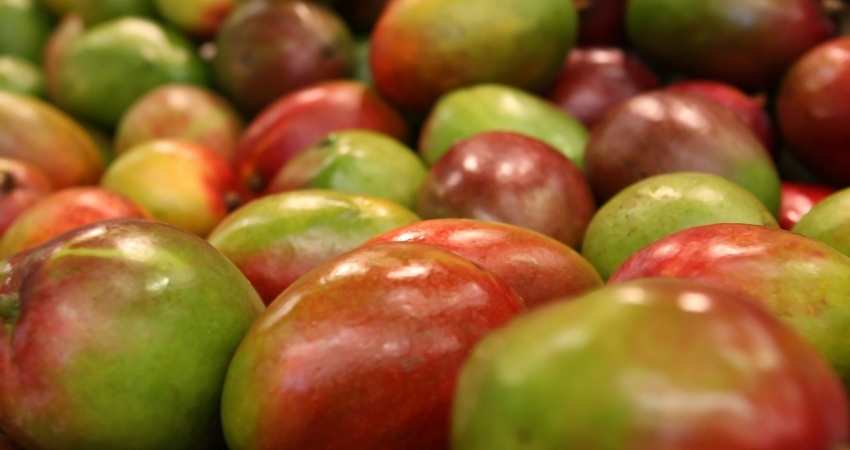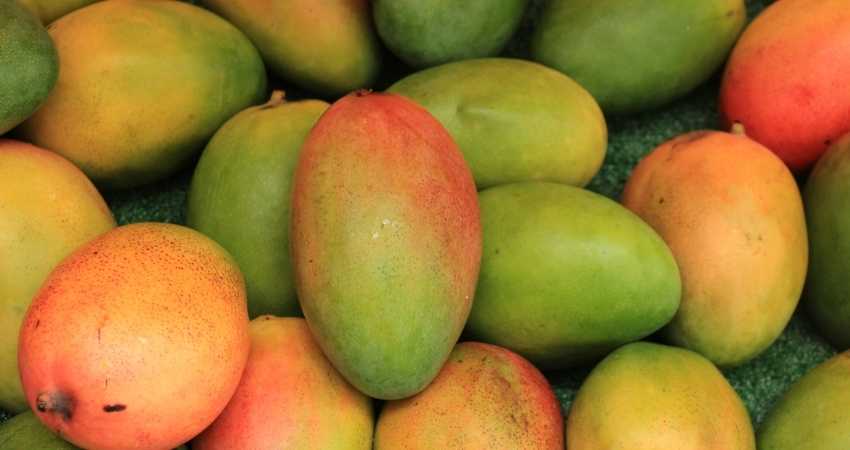This is When Mangoes Are REALLY Ready to Eat
It’s hard to know when mangoes are ready to eat. Therefore, let’s take a close look.
Mango is ready to eat by feeling its firmness and looking at the color. A mango is ready to eat when it is ripe, you will know if it is ripe when it changes its color from green to yellow or red. The Mango will also feel soft rather than hard. Any sign of green or hard feel means that the Mango is not yet ready to eat.
In this article, we are going in-depth with everything you need to know about when is the right time to eat a Mango.
When Is Mango Ready To Eat?

As a Certified Health Coach many clients ask me about healthy fruit including mangoes. Also, I purchase and consume it almost every month. Therefore, I have researched this topic in the past and present. Let’s examine the topic closely.
While there are many different varieties of Mango ((Mango.org: So Many Mangos to Choose from in June!)), a few signs are universal you can use to determine if a Mango is ready to eat or not. Knowing this could help you prevent a situation where you might eat an unripe or overripe Mango.
The universal rule takes into account the color and feel of the Mango ((Eat Fresh: Mango)). Let’s take a look at these in more detail.
When Mangoes Are Ready To Eat: The Color
The two most common colors for Mangoes are yellow, red, and orange/goldish. Some Mangoes are red with yellow shades or yellow with red shades. You’ll also get completely yellow or completely red mangoes when they are ripe.
There should never be green on a Mango. If it does have a fair amount of green coloring, it means the Mango is not ripe yet. While color is an indicator of ripeness, it’s not as important as the feel1.
The Feel
Mangos often have a great texture. One could argue that, in terms of fruit, they have one of the best textures. If you are struggling to determine if a Mango is ready by looking at the color, your next option is to go by the feel which is the more important of the two2.
A Mango firm but soft enough to be pressed in with little effort, is normally ready to eat3. If the Mango is too firm, it means that it is most probably not ripe yet.
Finally, a mango that can be squashed with little to no effort means that it might be overripe.

What If You Eat A Mango That Is Not Ripe?
If you try to eat a Mango that has barely started to go ripe, you won’t get very far before you give up.
The Mango will be extremely sour. Let’s say you eat a Mango that has been ripening for a while but is not yet fully ripe. In most cases nothing should happen, but you might not enjoy it that much. Let’s go into some more detail.
A Mango that is not properly ripe will have a higher concentration of acids than sugars. So, an unripe Mango might taste bitter, and it will be harder than usual. The acidity is not good for you and if you eat too many unripe Mangoes, you could start to feel a little ill.
The sugars found in Mangoes only start forming when the Mango starts becoming ripe. Until then, the Mango consists mainly of acids. The acid in unripe fruit is not necessarily bad for you but if you overdo it, you could start feeling ill. The acid could cause:
- Stomach cramps
- Nausea
- Diarrhea
- Fatigue
These complications are rare but are most definitely worth noting.
Also, somebody told me eating mango can make you gain weight. I just had to write a blog post on that which you can read by clicking here, Will Mango Make You Fat? Mango Myths & Facts Revealed.
What If You Eat A Mango That Is Overripe?
You might be thinking an overripe Mango should be fine. In some cases yes, it should still be fine. There is one thing to look out for and that is, the Mango might be going bad. You will not always see this until you eat most of it. You won’t see it because the Mango always starts going bad from the pit.
If you eat a Mango that is overripe, it will be very sweet which some people actually like. If the Mango is too overripe and it tastes somewhat sour, it means it has started going bad at the pit. It is never nice to only realize this once you have almost finished the Mango.
How To Tell If A Mango Is Overripe
If you are unsure as to whether or not a Mango is overripe you could use two methods to help you decide. The first method has already been discussed in the article, and that is to feel the Mango.
Another way of seeing if a Mango is overripe is to look at it and see if there are any serious dents in it. If there are, it could mean the Mango is starting to go bad at the pit and the Mango is falling in at that spot. This method is not very reliable, but I have a great solution for you.
What To Do If You Are Not Sure If A Mango Is Overripe
If you have taken a look at the Mango and felt it but are still unsure if it is overripe or not, This is what you should do.
After peeling the Mango, check the underside of the peel for any black spots. Then you’ll want to cut the Mango fruit in slices and away from the pit. If there are any black spots near the pit, cut around it.
Doing this will ensure you only eat the good parts of the fruit while avoiding the bad if there are any. The Mango might still taste a little bit more bitter than usual but hey, it’s still gonna taste good.
How To Ripen Mangoes At Home
If you are really craving a Mango but your local fruit grocer does not have any ripe ones yet, you can still buy them, take them home and ripen them there. You can generally speed up the ripening process to go faster than it would at the grocery store.
Place the Mangoes in brown paper bags or even wrap them up in a newspaper ((Fruits & Veggies: Mango)). It is best if you do them individually and make sure they aren’t in the same bag or newspaper together. Keep the Mangos at room temperature and put them in a dark cupboard.
Check on the Mangoes every day just to make sure, but do not leave them in there for too long. You can use this method to speed up the ripening process to take as little as 2 days depending on how far along they were already.
Once a mango is fully ripe, it can be stored in the fridge and will slow down the ripening process. Typically, it can stay in the fridge whole for up to five days and two to three when cut up. Mangoes can also be stored frozen for up to six month ((Mango.org: Get To Know Your Mango)).
If you have any questions to ask me about this article don’t hesitate to comment below or email us. You can find an email on our contact page.
Read Next – More Anti-Aging Foods!
A Mango Taste Guide From Bitter to Sweet
Mango Skin Magic – Secrets of the Mango Skin!
- Mango.org: Get To Know Your Mango [↩]
- USDA: Mangos [↩]
- Mango.org: How To Choose A Mango [↩]
